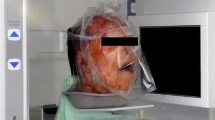Abstract
Objectives
The objective of this study is to compare subjective image quality and diagnostic validity of cone-beam CT (CBCT) panoramic reformatting with digital panoramic radiographs.
Materials and methods
Four dry human skulls and two formalin-fixed human heads were scanned using nine different CBCTs, one multi-slice CT (MSCT) and one standard digital panoramic device. Panoramic views were generated from CBCTs in four slice thicknesses. Seven observers scored image quality and visibility of 14 anatomical structures. Four observers repeated the observation after 4 weeks.
Results
Digital panoramic radiographs showed significantly better visualization of anatomical structures except for the condyle. Statistical analysis of image quality showed that the 3D imaging modalities (CBCTs and MSCT) were 7.3 times more likely to receive poor scores than the 2D modality. Yet, image quality from NewTom VGi® and 3D Accuitomo 170® was almost equivalent to that of digital panoramic radiographs with respective odds ratio estimates of 1.2 and 1.6 at 95% Wald confidence limits. A substantial overall agreement amongst observers was found. Intra-observer agreement was moderate to substantial.
Conclusions
While 2D-panoramic images are significantly better for subjective diagnosis, 2/3 of the 3D-reformatted panoramic images are moderate or good for diagnostic purposes.
Clinical relevance
Panoramic reformattings from particular CBCTs are comparable to digital panoramic images concerning the overall image quality and visualization of anatomical structures. This clinically implies that a 3D-derived panoramic view can be generated for diagnosis with a recommended 20-mm slice thickness, if CBCT data is a priori available for other purposes.




Similar content being viewed by others
References
Numata H (1933) Consideration of the parabolic radiography of the dental arch. J Shimazu Stud 10:13
Paatero Y (1949) A new tomographic method for radiographing curved outer surfaces. Acta Radiol 32:177
Paatero Y (1948) The use of a mobile source of light in radiography. Acta Radiol 29:221
Tronje G, Eliasson S, Julin P, Welander U (1981) Image distortion in rotational panoramic radiography. II. Vertical distances. Acta Radiol Diagn (Stockh) 22:449–455
Tronje G, Welander U, McDavid WD, Morris CR (1981) Image distortion in rotational panoramic radiography. III. Inclined objects. Acta Radiol Diagn (Stockh) 22:585–592
Tronje G, Welander U, McDavid WD, Morris CR (1981) Image distortion in rotational panoramic radiography. I. General considerations. Acta Radiol Diagn (Stockh) 22:295–299
Wyatt DL, Farman AG, Orbell GM, Silveira AM, Scarfe WC (1995) Accuracy of dimensional and angular measurements from panoramic and lateral oblique radiographs. Dentomaxillofac Radiol 24:225–231
Chenin DL (2010) 3D cephalometrics: the new norm. Alpha Omegan 103:51–56
Swennen GR, Schutyser F (2006) Three-dimensional cephalometry: spiral multi-slice vs cone-beam computed tomography. Am J Orthod Dentofacial Orthop 130:410–416. doi:10.1016/j.ajodo.2005.11.035
Pawelzik J, Cohnen M, Willers R, Becker J (2002) A comparison of conventional panoramic radiographs with volumetric computed tomography images in the preoperative assessment of impacted mandibular third molars. J Oral Maxillofac Surg 60:979–984. doi:10.1053/joms.2002.34399
Mischkowski RA, Ritter L, Neugebauer J, Dreiseidler T, Keeve E, Zoller JE (2007) Diagnostic quality of panoramic views obtained by a newly developed digital volume tomography device for maxillofacial imaging. Quintessence Int 38:763–772
Angelopoulos C, Thomas SL, Hechler S, Parissis N, Hlavacek M (2008) Comparison between digital panoramic radiography and cone-beam computed tomography for the identification of the mandibular canal as part of presurgical dental implant assessment. J Oral Maxillofac Surg 66:2130–2135. doi:10.1016/j.joms.2008.06.021
Agresti A (2007) An introduction to categorical data analysis, 2nd edn. Wiley, New Jersey
Landis JR, Koch GG (1977) The measurement of observer agreement for categorical data. Biometrics 33:159–174
Gijbels F, De Meyer AM, Bou Serhal C, Van den Bossche C, Declerck J, Persoons M, Jacobs R (2000) The subjective image quality of direct digital and conventional panoramic radiography. Clin Oral Investig 4:162–167. doi:10.1007/s007840000040162.784
Ludlow JB, Laster WS, See M, Bailey LJ, Hershey HG (2007) Accuracy of measurements of mandibular anatomy in cone beam computed tomography images. Oral Surg Oral Med Oral Pathol Oral Radiol Endod 103:534–542. doi:10.1016/j.tripleo.2006.04.008
Van Elslande D, Heo G, Flores-Mir C, Carey J, Major PW Accuracy of mesiodistal root angulation projected by cone-beam computed tomographic panoramic-like images. Am J Orthod Dentofacial Orthop 137:S94-99. doi:10.1016/j.ajodo.2009.02.028
Pauwels R, Beinsberger J, Collaert B, Theodorakou C, Rogers J, Walker A, Cockmartin L, Bosmans H, Jacobs R, Bogaerts R, Horner K (2012) Effective dose range for dental cone beam computed tomography scanners. Eur J Radiol 81:267–271. doi:10.1016/j.ejrad.2010.11.028
Acknowledgments
The authors wish to thank Olivia Nackaerts, Jilke Beinsberger, Christiano Oliveira, Bart Vandenberghe and Walter Coudyzer who helped us with the scanning. We also would like to thank Bruno Collaert, Heverlee, Belgium; Marc Hermans, Brussels, Belgium; Jules Poukens, Hasselt, Belgium; Pieter Avontroodt, Breda, The Netherlands; Olaf Veth, Zwolle, The Netherlands; Norbert Bellaiche, Paris, France; David Roudergues, Paris, France for offering their CBCT devices for the scanning of our samples.
Funding sources
This study was accomplished by a doctoral scholarship in the framework of the Interfaculty Council for Development Co-operation (IRO) and the bilateral collaborative project grant between Flanders, Belgium and Brazil (Fonds Wetenschappelijk Onderzoek—Vlaanderen-Conselho Nacional de Desenvolvimento Cientifico Tecnológico (FWO-CNPq)).
Conflict of interest
The authors declare that they have no conflict of interest.
Author information
Authors and Affiliations
Corresponding author
Rights and permissions
About this article
Cite this article
Pittayapat, P., Galiti, D., Huang, Y. et al. An in vitro comparison of subjective image quality of panoramic views acquired via 2D or 3D imaging. Clin Oral Invest 17, 293–300 (2013). https://doi.org/10.1007/s00784-012-0698-0
Received:
Accepted:
Published:
Issue Date:
DOI: https://doi.org/10.1007/s00784-012-0698-0




